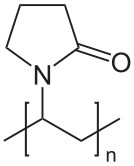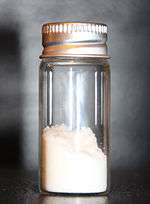Polyvinylpyrrolidone
Polyvinylpyrrolidone (PVP), also commonly called polyvidone or povidone, is a water-soluble polymer made from the monomer N-vinylpyrrolidone.[1]
 | |
 | |
| Names | |
|---|---|
| IUPAC name
1-ethenylpyrrolidin-2-one | |
| Other names
PVP, Povidone PVPP, Crospovidone, Polyvidone | |
| Identifiers | |
3D model (JSmol) |
|
| Abbreviations | PVP, PVPP, NVP, PNVP |
| ChEMBL | |
| ChemSpider |
|
| ECHA InfoCard | 100.111.937 |
| E number | E1201 (additional chemicals) |
CompTox Dashboard (EPA) |
|
| |
| Properties | |
| (C6H9NO)n | |
| Molar mass | 2,500 – 2,500,000 g·mol−1 |
| Appearance | white to light yellow, hygroscopic, amorphous powder |
| Density | 1.2 g/cm3 |
| Melting point | 150 to 180 °C (302 to 356 °F; 423 to 453 K) (glass temperature) |
Except where otherwise noted, data are given for materials in their standard state (at 25 °C [77 °F], 100 kPa). | |
| Infobox references | |
Uses
Medical
PVP was used as a plasma volume expander for trauma victims after the 1950s. It is not preferred as volume expander due to its ability to provoke histamine release and also interfere with blood grouping.
It is used as a binder in many pharmaceutical tablets;[2] it simply passes through the body when taken orally. (However, autopsies have found that crospovidone (PVPP) contributes to pulmonary vascular injury in substance abusers who have injected pharmaceutical tablets intended for oral consumption.[3] The long-term effects of crospovidone or povidone within the lung are unknown.)
PVP added to iodine forms a complex called povidone-iodine that possesses disinfectant properties.[4] This complex is used in various products like solutions, ointment, pessaries, liquid soaps and surgical scrubs. It is known under the trade names Pyodine and Betadine, among a plethora of others.
It is used in pleurodesis (fusion of the pleura because of incessant pleural effusions). For this purpose, povidone iodine is equally effective and safe as talc, and may be preferred because of easy availability and low cost.[5]
PVP is used in some contact lenses and their packaging solutions. It reduces friction, thus acting as a lubricant, or wetting agent, built into the lens. Examples of this use include Bausch & Lomb's Ultra contact lenses with MoistureSeal Technology[6] and Air Optix contact lens packaging solution (as an ingredient called "copolymer 845").[7]
PVP is used as a lubricant in some eye drops, e.g. Bausch & Lomb's Soothe.[8]
Technical
PVP is also used in many technical applications:
- as an adhesive in glue stick and hot-melt adhesives
- as a special additive for batteries, ceramics, fiberglass, inks, and inkjet paper, and in the chemical-mechanical planarization process
- as an emulsifier and disintegrant for solution polymerization
- to increase resolution in photoresists for cathode ray tubes (CRT)[9]
- in aqueous metal quenching
- for production of membranes, such as dialysis and water purification filters
- as a binder and complexation agent in agricultural applications such as crop protection, seed treatment and coating
- as a thickening agent in tooth whitening gels[10]
- as an aid for increasing the solubility of drugs in liquid and semi-liquid dosage forms (syrups, soft gelatine capsules) and as an inhibitor of recrystallisation
- as an additive to Doro's RNA extraction buffer
- as a liquid-phase dispersion enhancing agent in DOSY NMR [11]
- as a surfactant, reducing agent, shape controlling agent and dispersant in nanoparticle synthesis and their self-assembly[12]
- as a stabilizing agent in all inorganic solar cells[13]
Other uses
PVP binds to polar molecules exceptionally well, owing to its polarity. This has led to its application in coatings for photo-quality ink-jet papers and transparencies, as well as in inks for inkjet printers.
PVP is also used in personal care products, such as shampoos and toothpastes, in paints, and adhesives that must be moistened, such as old-style postage stamps and envelopes. It has also been used in contact lens solutions and in steel-quenching solutions.[14][15] PVP is the basis of the early formulas for hair sprays and hair gels, and still continues to be a component of some.
As a food additive, PVP is a stabilizer and has E number E1201. PVPP (crospovidone) is E1202. It is also used in the wine industry as a fining agent for white wine and some beers.
In molecular biology, PVP can be used as a blocking agent during Southern blot analysis as a component of Denhardt's buffer. It is also exceptionally good at absorbing polyphenols during DNA purification. Polyphenols are common in many plant tissues and can deactivate proteins if not removed and therefore inhibit many downstream reactions like PCR.
In microscopy, PVP is useful for making an aqueous mounting medium.[16]
PVP can be used to screen for phenolic properties, as referenced in a 2000 study on the effect of plant extracts on insulin production.[17]
Safety
The U.S. Food and Drug Administration (FDA) has approved this chemical for many uses,[18] and it is generally considered safe. However, there have been documented cases of allergic reactions to PVP/povidone, particularly regarding subcutaneous (applied under the skin) use and situations where the PVP has come in contact with autologous serum (internal blood fluids) and mucous membranes. For example, a boy having an anaphylactic response after application of PVP-Iodine for treatment of impetigo was found to be allergic to the PVP component of the solution.[19] A woman, who had previously experienced urticaria (hives) from various hair products, later found to contain PVP, had an anaphylactic response after povidone-iodine solution was applied internally. She was found to be allergic to PVP.[20] In another case, a man experiencing anaphylaxis after taking acetaminophen tablets orally was found to be allergic to PVP.[21]
Povidone is commonly used in conjunction with other chemicals. Some of these, such as iodine, are blamed for allergic responses, although testing results in some patients show no signs of allergy to the suspect chemical. Allergies attributed to these other chemicals may possibly be caused by the PVP instead.[22][23]
Properties
PVP is soluble in water and other polar solvents. For example, it is soluble in various alcohols, such as methanol and ethanol,[24] as well as in more exotic solvents like the deep eutectic solvent formed by choline chloride and urea (Relin).[25] When dry it is a light flaky hygroscopic powder, readily absorbing up to 40% of its weight in atmospheric water. In solution, it has excellent wetting properties and readily forms films. This makes it good as a coating or an additive to coatings.
A 2014 study found fluorescent properties of PVP and its oxidized hydrolyzate.[26]
History
PVP was first synthesized by Walter Reppe and a patent was filed in 1939 for one of the derivatives of acetylene chemistry. PVP was initially used as a blood plasma substitute and later in a wide variety of applications in medicine, pharmacy, cosmetics and industrial production.[27][28]
Cross-linked derivatives
See also
References
- Haaf, F.; Sanner, A.; Straub, F. (1985). "Polymers of N-Vinylpyrrolidone: Synthesis, Characterization and Uses". Polymer Journal. 17: 143–152. doi:10.1295/polymj.17.143.
- Bühler, Volker (2005). Polyvinylpyrrolidone Excipients for Pharmaceuticals: Povidone, Crospovidone and Copovidone. Berlin, Heidelberg, New York: Springer. pp. 1–254. doi:10.1007/b138598. ISBN 978-3540234128.
- Ganesan, S; Felo, J; Saldana, M; Kalasinsky, V. F.; Lewin-Smith, M. R.; Tomashefski Jr, J. F. (2003). "Embolized crospovidone (polyN-vinyl-2-pyrrolidone) in the lungs of intravenous drug users". Modern Pathology. 16 (4): 286–92. doi:10.1097/01.MP.0000062653.65441.DA. PMID 12692192.
- PVP-Iodine. ispcorp.com. 2004.
- Das SK, Saha SK, Das A, Halder AK, Banerjee SN, Chakraborty M (2008). "A study of comparison of efficacy and safety of talc and povidone iodine for pleurodesis of malignant pleural effusions". Journal of the Indian Medical Association. 106 (9): 589–90, 592. PMID 19552086.
- "Contact Lens Design & Materials: New Lens Technology Targets Improved Vision and Comfort". Contact Lens SPECTRUM. May 1, 2014. Retrieved Sep 27, 2017.
- "Contact Lens Design & Materials: The Evolution of Contact Lens Wetting Agents". Contact Lens SPECTRUM. October 1, 2009. Retrieved Sep 27, 2017.
- "Soothe Hydration Lubricant Eye Drops". Bausch & Lomb. Retrieved Sep 27, 2017.
- Swei, J.; Talbot, J. B. (2006). "Development of high-definition aqueous polyvinylpyrrolidone photoresists for cathode ray tubes". Journal of Applied Polymer Science. 102 (2): 1637–1644. doi:10.1002/app.23950.
- Chen, Tianming "Dental bleach", U.S. Patent 6,730,316, Priority date January 27, 2001
- Kavakka, J. S.; KilpeläInen, I.; Heikkinen, S. (2009). "General Chromatographic NMR Method in Liquid State for Synthetic Chemistry: Polyvinylpyrrolidone Assisted DOSY Experiments". Organic Letters. 11 (6): 1349–52. doi:10.1021/ol9001398. PMID 19231850.
- Koczkur, Kallum M.; Mourdikoudis, Stefanos; Polavarapu, Lakshminarayana; Skrabalak, Sara E. (2015). "Polyvinylpyrrolidone (PVP) in nanoparticle synthesis" (PDF). Dalton Transactions. 44 (41): 17883–17905. doi:10.1039/C5DT02964C. PMID 26434727.
- Li, Bo; Zhang, Yanan; Fu, Lin. "Surface passivation engineering strategy to fully-inorganic cubic CsPbI 3 perovskites for high-performance solar cells" (PDF). Nature: 8.
- Fischer, Frank & Bauer, Stephan (2009). "Ein Polyvinylpyrrolidon (PVP): ein vielseitiges Spezialpolymer – Verwendung in der Keramik und als Metallabschreckmedium". Keramische Zeitschrift. 61 (6): 382–385.
- Göthlich, Alexander; Koltzenburg, Sebastian; Schornick, Gunnar (2005). "Funktionale Polymere im Alltag: Vielseitig". Chemie in Unserer Zeit. 39 (4): 262–273. doi:10.1002/ciuz.200400346.
- Lillie RD & Fullmer HM (1976) Histopathologic Technic and Practical Histochemistry, 4th ed. New York: McGraw-Hill, p. 411. ISBN 0-07-037862-2.
- Broadhurst, C. Leigh; Polansky, Marilyn M; Anderson, Richard A (March 2, 2000). "Insulin-like Biological Activity of Culinary and Medicinal Plant Aqueous Extracts in Vitro". Journal of Agricultural and Food Chemistry. 48 (3): 849–52. doi:10.1021/jf9904517. PMID 10725162.
- Inactive Ingredients in FDA Approved Drugs. FDA/Center for Drug Evaluation and Research, Office of Generic Drugs, Division of Labeling and Program Support. Database Update Frequency: Quarterly. Data Through: January 6, 2010. Database Last Updated: January 13, 2010 – search on povidone for list of approved items
- Yoshida K, Sakurai Y, Kawahara S, et al. (2008). "Anaphylaxis to polyvinylpyrrolidone in povidone-iodine for impetigo contagiosum in a boy with atopic dermatitis". International Archives of Allergy and Immunology. 146 (2): 169–73. doi:10.1159/000113522. PMID 18204285.
- Adachi A, Fukunaga A, Hayashi K, Kunisada M, Horikawa T (March 2003). "Anaphylaxis to polyvinylpyrrolidone after vaginal application of povidone-iodine". Contact Dermatitis. 48 (3): 133–6. doi:10.1034/j.1600-0536.2003.00050.x. PMID 12755725.
- Rönnau AC, Wulferink M, Gleichmann E, et al. (November 2000). "Anaphylaxis to polyvinylpyrrolidone in an analgesic preparation". The British Journal of Dermatology. 143 (5): 1055–8. doi:10.1046/j.1365-2133.2000.03843.x. PMID 11069520.
- Katelaris, Constance (2009). "'Iodine Allergy' label is misleading". Australian Prescriber. 32 (5): 125–128. doi:10.18773/austprescr.2009.061.
- van Ketel WG, van den Berg WH (January 1990). "Sensitization to povidone-iodine". Dermatologic Clinics. 8 (1): 107–9. doi:10.1016/S0733-8635(18)30531-X. PMID 2302848.
- Wohlfarth, C (2010). "Thermodynamic Properties of Polymer Solutions.". Landolt-Börnstein, New Series, Group VIII, Volume 6D. Landolt-Börnstein - Group VIII Advanced Materials and Technologies. 6D2. Springer Verlag. pp. 1266–1267. Bibcode:2010LanB..6D2.1266W. doi:10.1007/978-3-642-02890-8_752. ISBN 978-3-642-02889-2.
- Sapir, L.; Stanley, CB.; Harries, D. (2016). "Properties of Polyvinylpyrrolidone in a Deep Eutectic Solvent". J. Phys. Chem. A. 120 (19): 3253–3259. Bibcode:2016JPCA..120.3253S. doi:10.1021/acs.jpca.5b11927. OSTI 1424493. PMID 26963367.
- Song, Guoshan; Lin, Yannan; Zhu, Zhongcheng; Zheng, Heying; Qiao, Jinping; He, Changcheng; Wang, Huiliang (2015). "Strong Fluorescence of Poly(N-vinylpyrrolidone) and Its Oxidized Hydrolyzate". Macromolecular Rapid Communications. 36 (3): 278–85. doi:10.1002/marc.201400516. PMID 25420749.
- Fischer, Frank; Bauer, Stephan (2009). "Polyvinylpyrrolidon. Ein Tausendsassa in der Chemie". Chemie in Unserer Zeit. 43 (6): 376–383. doi:10.1002/ciuz.200900492.
- Koczkur, Kallum M.; Mourdikoudis, Stefanos; Polavarapu, Lakshminarayana; Skrabalak, Sara E. (2015). "Polyvinylpyrrolidone (PVP) in nanoparticle synthesis" (PDF). Dalton Transactions. 44 (41): 17883–17905. doi:10.1039/C5DT02964C. PMID 26434727.